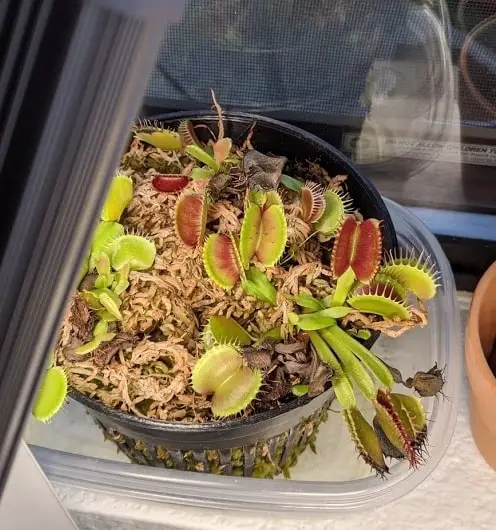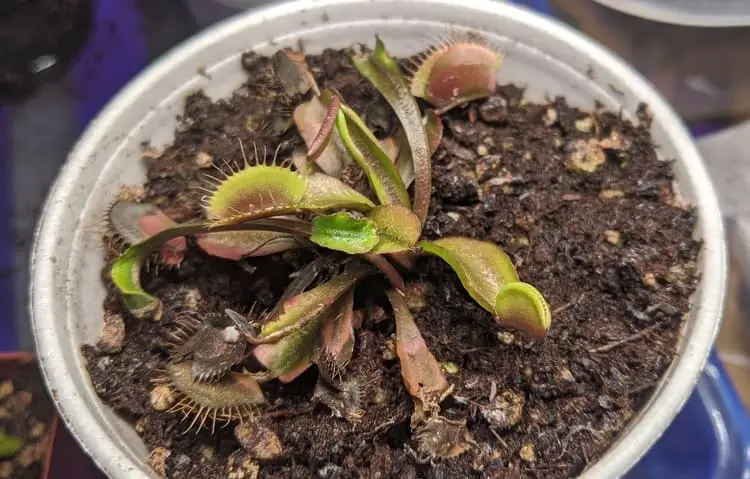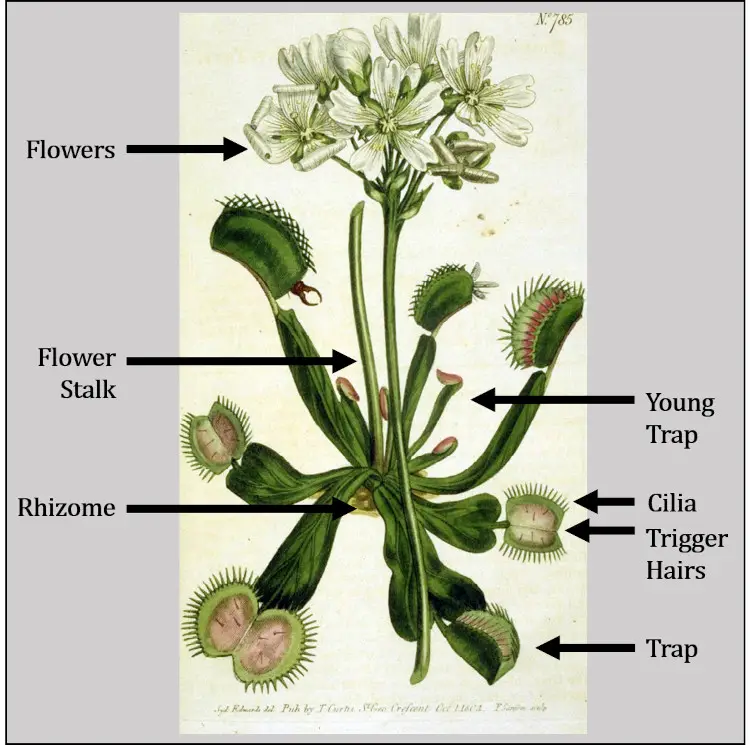Venus flytraps exhibit different appearances through the seasons and due to environmental changes. This article explores the main reasons why Venus flytraps stop producing traps.
Venus flytraps might have no traps due to dormancy or lack of lighting. Venus flytraps stop producing leaves when they do not receive enough light exposure. Without traps, the plant will weaken and can eventually die.
Depending on the status of your plant, you should take different approaches. The table summarizes the most common situations. Also, it describes some action steps I explain in detail through the article.
| Venus Flytrap Status | Action Steps |
| The plant sporadically grows leaves without a trap | It is normal for a Venus flytrap to randomly produce some unperfect leaves. Focus on providing proper care and make adjustments only if the issue intensifies |
| The Venus flytrap is growing leaves, but none of them have traps | The plant is suffering from light starvation. The appearance of the plant is a clear sign of poor light exposure. Provide at least 6+ of light daily. Read the section on “Proper Lighting” to perfect your setup. |
| It is winter and the plant is not growing as usual. | Your Venus flytrap might be experiencing dormancy. It is a normal process. During this period, you must ensure proper care. |
Now that you know why your Venus fly trap is producing no leaves, it is time for the solution. The following sections will get into the details on how to bring your plant back to life.
How to Fix a Venus Flytrap With No Traps
Sometimes Venus flytraps produce leaves without a fully developed trap. This can be normal when it is sporadic or during dormancy. But, if the plant is not dormant and produces multiple leaves without a trap or no traps at all. Then, there might be a problem. But, do not worry, proper lighting can fix Venus flytraps without traps. I will teach you how to fix it. Also, make sure to read the Dormancy section if you are unsure of your plant’s status.
Provide Proper Lighting
Venus flytraps are unique plants. In their natural habitat, they receive plenty of sunlight and water. And, at home should be no different.
Optimally, Venus flytraps should receive 12 hours of light. A minimum of 4-6 hours of light is required to keep Venus flytraps healthy. The lighting requirement can be fulfilled through natural light or artificial light.
Without access to proper lighting, Venus flytraps stop producing traps to focus on photosynthesis. The plant has adapted to survive in extreme habitats. But, they do require above average light exposure.
The easiest way to fulfill the light requirement is to place Venus flytraps outdoors. If you live in a sunny location, Venus flytraps thrive outside. Even under partial shade, the plant can grow healthy. However, they prefer direct sunlight as long as the temperature is not too extreme.
Venus flytraps can live happily in temperatures between 32 -95 F (0- 35 C).
You can also consider placing your plant on a sunny windowsill. Venus flytraps are optimal candidates for windowsill growing. Pick a window with at least 6 hours of light exposure, and your plant will start growing traps.
Changing the placement of your Venus flytrap takes less than a few minutes and resolves your problems quickly. However, not everyone is lucky enough to live in a sunny area or have a bright window. Some of us live in homes without natural light. For such cases, artificial lighting is the solution.
An Alternate Solution: Artificial Lighting
Sometimes it is difficult to fulfill the Venus flytrap lighting requirement with natural light. Luckily, there is an alternate solution.
Venus flytraps can grow healthy under artificial lighting. High output fluorescent light, such as T8 bulbs, provide adequate light intensity. Also, LED plant light can provide proper lighting.
Artificial lighting can be used as the sole lighting source or as a supplement. If you are already growing your Venus flytrap on a windowsill, but the sunlight is not enough, you can go ahead and add a small LED plant light as a supplement.
You have two options for artificial lighting:
- High output fluorescent lights
- LED plant lights
Both are effective and can be inexpensive, depending on how you build your setup. If you choose fluorescent light, you can get T8 bulbs in pet stores or the hardware store. Preferably choose cool colors to avoid overheating. For LED lights, choose 40-50 Watt LED lights. I have used this small and economical LED plant light to grow some of my Venus flytraps, and they are thriving. It cost me less than 30 dollars, but you can check the price and description on Amazon.com by following the link since the price is always changing.
The picture below shows some of my plants under my bright LED plant light. The plants are growing big and healthy traps. Also, the bright colors are a healthy sign of proper light exposure.

How to Introduce Venus Flytraps to Better Lighting
Venus flytraps require lots of light to be healthy. However, introducing them too fast can create problems. Moving a Venus flytrap from shade to direct sunlight can generate sunburns. Believe it or not, plants can also suffer from sunburns.
When increasing the light exposure for your Venus flytrap. It is recommended to do it step by step. For example, you can increase the light exposure by one hour every day. Within a week, your plant will be adjusted to the changes in lighting.
I bought the plant in the picture online. The shipping process took several weeks. Once the plant arrived, it barely had any leaves. And the existing ones did not have traps. After 4 weeks under bright LED lights, the plant is growing some traps!

When Would You Notice the Changes?
Venus flytraps grow rapidly. They are always growing new leaves. After making the changes in your setup, you will start to observe some changes in your plant.
Be patient and wait for new growth. Within a week or two, the plant should produce some new leaves. The new growth will exhibit traps due to the lighting. Do not expect existing leaves to grow new traps suddenly; that won’t happen. Only new leaves will grow traps.
Lack of Traps During Dormancy
Dormancy is a natural process for Venus flytraps. During the winter months, Venus flytraps experience a resting period that is called dormancy. During this time, the plant might not exhibit its best looks.
Dormant Venus flytraps lose a bunch of leaves, shrink, and in some cases, stop producing traps. You can always provide proper lighting. But consider that if your plant is dormant, it will look very different.
Venus flytraps enter dormancy during the winter after being exposed to several weeks of temperatures below 45 F (7 C). Then, Venus flytraps remain dormant for several months, usually two to three months. But, do not worry; the plant will exit dormancy eventually and start growing strongly once again.
Do Venus Flytraps Grow New Traps?
Venus flytraps continue to grow throughout their lifetime, which could surpass two decades. They continuously produce new leaves as old ones wither.
Venus flytraps grow new traps often. The traps are only active for a limited amount of time. Then, once a leaf starts to wither, a new one starts growing.
The Continuous growth of new traps is a clear sign a Venus flytrap is healthy and thriving.

Do Venus Flytraps Die Without Traps?
The traps of a Venus flytrap are essential to capture bugs. However, the plant can live without traps.
Venus flytraps don’t die without traps. Even though they can’t capture insects, they can produce their own food through photosynthesis. The nutrients Venus flytraps extract from insects are just a supplement, not their main nutrition source.
Venus flytraps do not need insects to survive. Plants can live their whole life without ever capturing a bug. Consuming insects boost their growth. But it is not a necessity.
Venus flytraps without traps won’t die due to their lack of traps. However, they can die because they are fragile, and anything can affect them. Growing Venus flytraps is a challenge! As a resource, I would like to share a couple of useful articles.
12 Reasons Why a Venus Flytrap is Unhealthy (with solutions): This article will help you identify why your plant might be unhealthy. Proper lighting is not the only consideration. Many other factors can weaken or kill your plant.
Ultimate Venus Flytrap Care Guide – Free Care Sheet Included: Venus flytraps are peculiar plants. In this article, you will learn everything about Venus flytrap care. Also, you can download a free care sheet for your reference.

